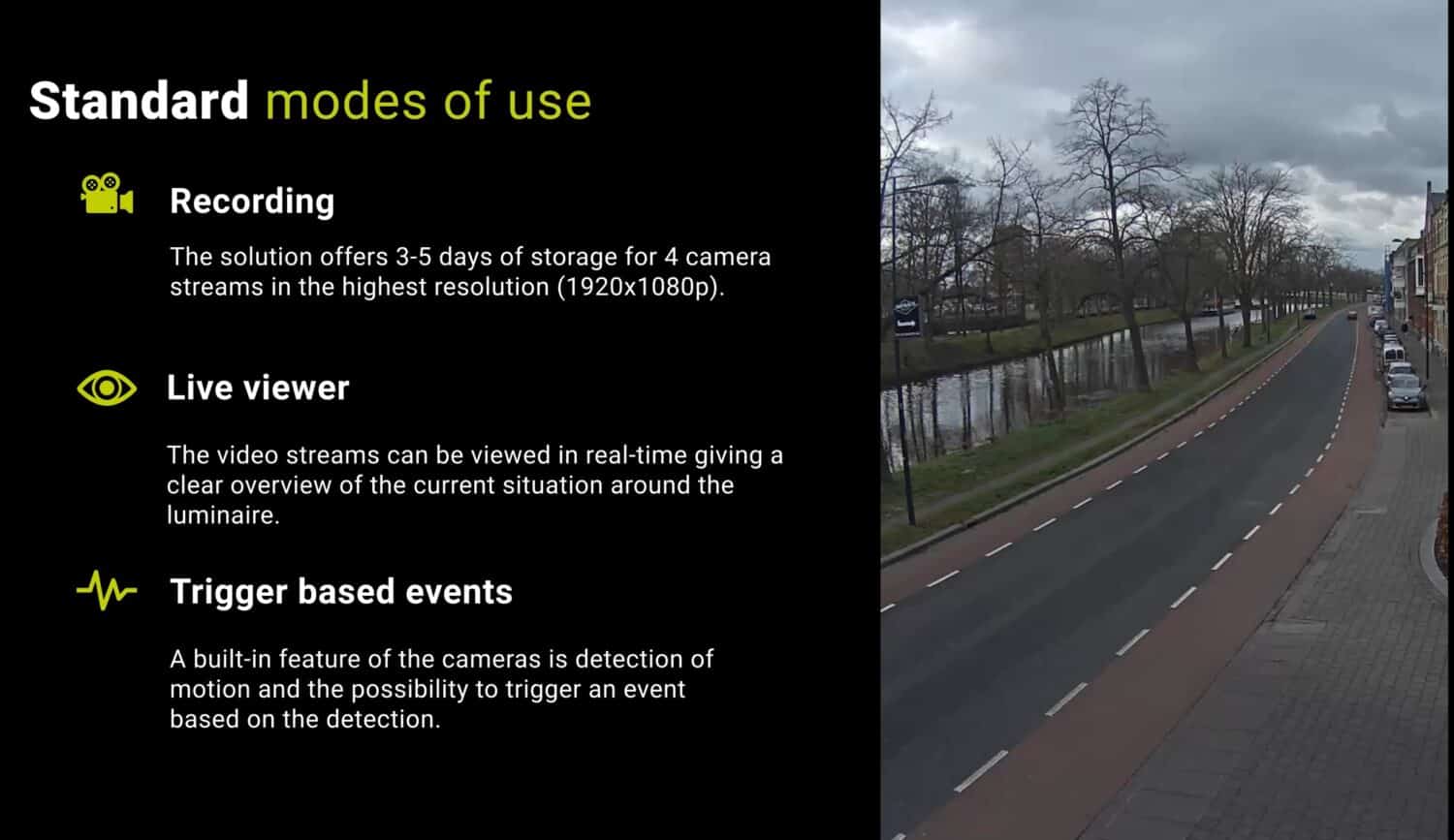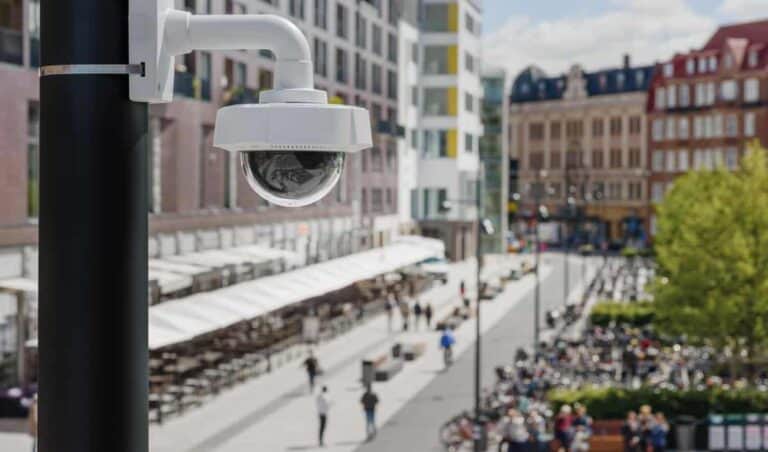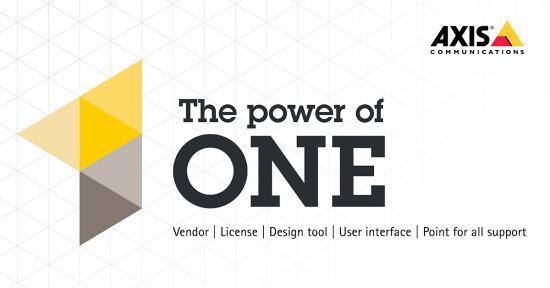Axis Communications recently launched the power of one concept. With this all-in-one security system, Axis wants to achieve simplicity, to organize everything around cameras from a single interface. It should also improve communication between cameras and systems. Axis even sees it as a way to enable new use cases. We talked about it with Manager Engineering and Training Middle Europe Jan-Bart Mul and Key Account Manager End Customers and smart city specialist Epko van Nisselrooij.
Axis is traditionally an ICT company that thinks in terms of IT processes and possibilities. Over the years, it has increasingly focused on the security market, as that is where the most growth opportunities lay. Partners, customers and Axis itself have been looking beyond surveillance cameras for years, and the power of one concept can support that.
In the first part of this story, we will therefore mainly discuss how the all-in-one concept works. Then we will go into some new use cases enabled by Axis.
Also read: Axis expands Object Analytics with smart surveillance options
The power of one brings islands together
Axis’ goal with the power of one is to provide one solution. That solution offers one interface, one license per device, one point of contact for support and one design tool. This should lead to full system compatibility and simpler business management. According to the surveillance camera vendor, this is much needed, as frustrations and problems often arise when installing and integrating new systems. These may include hardware not supported by the video management system (VMS) or software delays. End users and system integrators in that more traditional approach therefore have to spend additional cost and time making a company’s entire surveillance infrastructure functional.
“As a result, we are focusing more and more on the whole process,” Mul explains. “This is actually twofold. On one side, we particularly want to move from individual components to a total chain solution. And, by bringing that more to us we can also ensure that it becomes a reliable chain. That is, ensuring both a working solution and a cyber-secure system.”
Central system for each component
As a company, choosing to use as much Axis hardware and software as possible should improve the setup and maintenance of your surveillance landscape. That better suits the multidisciplinary deployment that customers need today, the gentlemen argue. As an example, they cite buying and installing a camera, then linking it to a third-party VMS and adding license plate recognition to it to control a barrier. In this case, as a company you have to deal with different components and brands. These need to communicate with each other, something the power of one supports.
Basically, it should not matter whether the solution is from Axis itself or from a partner or other supplier. Axis has built its products according to ONVIF standards as much as possible. This should ensure interoperability with IP-based security hardware. If a partner or competitor’s product also follows ONVIF standards, then there is compatibility with the power of one. Images can therefore be shared back and forth, while it is also possible, for example, to possibly move cameras. The power of one thus means that Axis actually prefers to take on as many things as possible, but does not force the customer to do so.
At the same time, adding new components to the surveillance infrastructure at a later stage should also simplify it. In the example of controlling a barrier, it might mean adding a horn speaker later. Previously, a system integrator or company would then have to understand all the different products and components. That should be faster now, Mul and Van Nisselrooij point out. “It is a guarantee for the end user that, if something needs to be changed, he can switch fairly quickly. In the central system, applications can also be adjusted and added again. A horn speaker, for example, to speak messages through the system, will be easy to connect to the system.”
Everything under control and secure data
What Mul and Van Nisselrooij also point out is that an all-in-one approach ensures that security can be taken to a higher level. Because everything comes together in one system, Axis can ensure that all cameras, components and software meet the highest cybersecurity requirements.
Making devices and software more secure is something Axis wants to achieve in part through end-to-end encryption. To this end, the company follows industry standards. For example, a higher level of security can be guaranteed by using signed firmware. Hackers can, for example, try to get users to install firmware with malicious code. With signed firmware, the integrity of the firmware can be verified before it is installed or upgraded on devices. Axis firmware is signed with a digital signature, which means it is based on RSA public-key encryption. In this case, the public key resides on the camera, while the private key is stored in a secure location at Axis.
In new cameras, Axis has reserved components for certificate handling. A user thus knows that a signed video is authentic. There is also the guarantee that when a camera is rebooted, everything is checked.
Patches and updates
In recent years, progress have also been made on the cyber front around patch management and updates. There is increasing attention to this in the industry because hackers are often able to get into Internet-connected devices through vulnerabilities. These vulnerabilities are addressed by patches and updates. Companies using Axis can choose to have those patches applied automatically or do so manually. To retrieve those patches, the cameras must be connected to the Internet.
If you are using Axis equipment currently for sale on the market, then there is the option to push any available patches. Only older cameras may no longer have support. However, Axis does offer long-term support (LTS) for older products, so businesses can still continue to use security patches for longer and maintain a high level of security.
Camera as sensor
So as far as Axis is concerned, more convenience and extra security are crucial to taking surveillance to the next level. In this way, the company is facilitating the increased use of cameras as sensors. Such a sensor is ideal as an edge application. “Because of the new possibilities from edge analysis in particular, you see that more use cases arise at once. Investments can be made much more broadly. For example, I have applications in cities where departments can securely share the metadata from the camera with other departments because there is no longer a link to the video so privacy can be ensured. So before, multiple departments could not use the same sensor as video was privacy-sensitive,” Van Nisselrooij said.
From his smart city background, Van Nisselrooij therefore sees a lot of new use cases emerging, partly because of the power of one. He reiterates that we used to work with separate systems for all kinds of applications. In recent years, however, a lot of technology is becoming network-based and linked to the Internet. Meanwhile, apps are also getting better and easier. That makes the new applications possible.
Linking cameras to light
A good example is the collaboration between Axis and Sustainder, which combines cameras with lighting. Together, they can address city challenges and find smart city applications. “In cities, they have more and more challenges because of urbanization, to keep the city livable and safe. With that, they are looking for a smart city solution, which connects sensors in the city better and also becomes complementary. That’s what this is all about. The lighting market, especially lighting poles, are ideally suited to provide connectivity to all kinds of sensors. You see all kinds of lighting vendors suddenly thinking about how they can make their luminaire serve as a kind of sensor hotel to offer more than just a lamp,” Van Nisselrooij explained.

This is where Sustainder and Axis found each other. They placed a camera in Sustainder’s lighting fixture. If a camera sees that people are present, the light can turn on. In the absence of people, the lights also turn off. Not leaving lights on all the time saves on energy costs and helps improve the environment.
Combination with sound
Another example put forward by Van Nisselrooij is the cooperation with Sorama. This vendor focuses on extracting more value from sound. “There you see an interesting combination with video, because that offers so much more room to assess things better. From a security perspective, we often sit and look at images. But if you have a fight, for example, a lot of verbal violence usually precedes that. So in that chain you can detect much earlier. But you also see from privacy purposes that you can classify traffic with sound, without directly involving video. So there are many more possibilities with sound than you initially think.”
Van Nisselrooij sees a crucial role for sound. For example, people and governments are switching to electric driving for air quality purposes. However, electric vehicles produce less noise than regular cars. That raises new safety issues. In addition, governments are looking at ways to prevent noise from becoming a stressor in society, Van Nisselrooij observes. Consider noise from construction traffic, construction work and low-flying aircraft.
“You can look at combining audio and video in many situations. We had a project in Eindhoven. There we used audio clips to switch between cameras. If aggression was picked up, the camera was controlled in that environment. That’s an integration we have with the microphone array, an assembly of multiple microphones. It made it possible to immediately give the observer the right images based on where something arose,” Van Nisselrooij points out.
Linking video to sound and lighting is one way to make surveillance multidisciplinary. For such things, businesses rely on the power of one concept, a tool that enables the new use cases and provides greater convenience.

